Buying Marketing Automation tool – how to start?
The strategy is the first step.
A marketing automation tool doesn’t help you with your strategy. Marketing automation tools help automate a strategy. So, the first step when selecting a tool is to document your strategy. Make sure you understand all the options when creating your strategy.
Inbound vs. outbound marketing
Outbound marketing strategies tend to focus on sending content or messages to prospects through telemarketing, direct mail, email, or other advertising campaigns. Inbound techniques are focused on getting customers to find you via search, referrals, social media, etc.
Size of company and customer base
Typically, smaller companies desire a suite tool that is easy to learn and handles a wide variety of features but only handles the most common use cases, like Infusionsoft, Zoho, and Hubspot. Larger companies often seek out a tool that handles more complex use cases, which usually takes longer to implement and requires more training. In addition, larger companies tend to have more specialized staff and, therefore, might choose to use several marketing tools that are designed to go deep in a certain area, like Agile CRM, or Zoho CRM/Marketing Hub.
Industry
The requirements for B2B vs. B2C companies often vary considerably. Strategies tend to be different, so automation requirements are different. Different sales cycles, emotional buying behavior, the number of people in the decision process, and the database size can all influence the software that will best fit your strategy.
Integrations
Often, the data that must be used to automate a marketing process is held in another system (CRM, ERP, image files, etc.). The number of data points and systems you need to integrate to can increase maintenance costs. On the other hand, many companies are looking for software with a very good API that can be easily integrated into their current systems.
Why do you need marketing automation?
typically, it should be the first question, and the answer should be simple – the effect of the scale on all marketing activities.
What should be done before buying a marketing automation tool?
A good first step in the marketing funnel is to ensure you can be found if someone is looking. This includes establishing a website optimized for search engines, making content available, and establishing and maintaining a social presence. Although many marketing automation suite tools handle this part of the funnel, you might want to consider specialized tools for Search Marketing, Content Marketing, Social Media Management, Public Relations, and Web Analytics.
Next steps to implement the marketing automation:
Lead capture/qualification
After establishing a presence, you must capture a lead when a prospect views your content or contacts you. Most marketing automation systems provide analytics to help you optimize your lead capture process. You can also enrich and score your leads based on the prospects’ behavior across all your touch points. In addition, you may want to do some outbound lead generation as well.
Four common places leads are captured:
- Web – web forms and landing pages in front of your contest that users access via your website, paid advertising, or other domains
- Trade shows and events – uploading captured leads to full event management functionality
- Emails – “cold emailing” to lists
- Call/SMS campaigns – “cold calling” to lists
Lead tracking, nurturing, and conversion
After establishing a presence and capturing leads, the leads need to be nurtured and ultimately converted to a sale. With marketing automation tools, you can nurture custom content and messages to individual leads to increase conversion.
Marketing channels
Most marketing automation suite tools focus on four channels:
Web
managing and analyzing content on your site or external sites and optimize search
Email
sending emails to generate leads and nurture existing leads
Social
managing social presence across multiple social media channels, including social analytics, monitoring social activity for your brand and your competitors’ brands, and managing the content across all the social media channels
Mobile
messaging via mobile and SMS marketing
Key Benefits of Marketing Automation Software
- Measure campaigns to optimize, justify, and prioritize initiatives
- Reduce time spent administering marketing programs and completing tasks
- Improve close rates with timely and relevant engagement
- Brand and messaging consistency across campaigns and channels via templates and standards
- Shorten sales cycles with quicker response times
- Customized marketing to each customer’s needs
- Scheduled and automated activities for around-the-clock engagement without manual effort
Common Features
These are the common features of Marketing Automation Software
Email Marketing
Automated Email Responses
Set up automated nurturing emails based on events, online activities, and lead scores. We propose using Mailchimp, Zoho Campaigns, or GetResponse.
Building and Personalizing Emails
Create and design emails with an editor; manage templates; personalize dynamically. Most email marketing apps have such editors which can help you in building very successful and correctly built emails.
Sending Outbound Emails
Create targeted lists, schedule and manage bulk email sending.
Manage Email Deliverability
Ensure inbox delivery. Includes opt-in management, bounce handling, unsubscribe processing, suppression lists, email preview, spam checking, link validation, and delivery monitoring.
Online Marketing
Mobile Optimized
Support mobile-optimized emails, online forms, and landing pages.
A/B Testing
Test alternate versions of emails, landing pages, and forms. Learn what works, maximize response rates, and increase conversion.
Dynamic Content
Dynamically customize emails, forms, and landing pages for specific segments of customers and prospects.
Landing Pages and Forms
Build customized landing pages and lead capture forms for specific marketing campaigns to maximize conversion and to capture the right qualifying information.
Search Tracking and Optimization
Track the performance of keywords and links in major search engines. Measure search rankings and performance. Improve page-level SEO with tools to diagnose and improve page performance. Integrate with Google AdWords.
Lead Management
CRM Lead Integration
Sync lead, contact, account, and opportunity information with your CRM system. Zoho CRM has very nice integration with web forms and other communication channels.
Automated Alerts and Tasks
Create tasks automatically and provide real-time sales alerts over email, RSS, or mobile devices.
Online Behavior Tracking
Track which emails a prospect opens and clicks, what web pages they visit, what keywords they use, and even what they say on social networks.
Lead Nurturing
Automate “drip marketing” campaigns that send relevant messages over time based on prospect behaviors and pre-defined campaign steps.
Lead Scoring and Grading
Automatically qualify and score leads based on demographics and prospect online behaviors, including recency and frequency. Assign your own weights to determine lead scores for prioritization.
Segmentation
Segment your database and build a list of target leads and contacts. Filter on demographic and company attributes (title, company size, location), behavioral filters, and CRM information. Zoho CRM helps with it. There are built-in segmentation options that are managed by AI.
Data Quality Management
Data quality consists of deduplication, cleansing, and appending your marketing database.
Marketing Lead Database
A marketing lead database records your most important marketing asset: your leads and contacts. Includes a view of all marketing interactions between each prospect and your company, including website visits, email clicks, scoring changes, and data updates/history. It is good to have one core database, like a CRM database, which is synchronized with other tools, like email sending and campaign management tools.
Campaign Management
Budgeting
Manage all aspects of marketing investments, including assigning top-down budgets to various groups and divisions, planning marketing spending across programs, tracking open-to-spend, ensuring budget compliance, coordinating workflows and permissions, and reconciling plans with actual invoices.
Calendars
Maintain a marketing calendar across multiple groups. Manage the calendar for the entire marketing department, from promotions to content to PR.
Event / Webinar Marketing
Streamline the entire event process, including personalized invitations, registration, reminders, and post-event follow-up. Integrate with online meeting tools like Zoho Meeting, WebEx, Adobe Connect, and GoToWebinar.
Program Management
Manage marketing campaigns and programs across multiple channels, including online ads, video campaigns, mobile, virtual events, and social media. Create and optimize program assets such as landing pages, emails, campaigns, and lists. Track program objectives, results, and costs to assess the program ROI. You can manage it in the Zoho CRM.
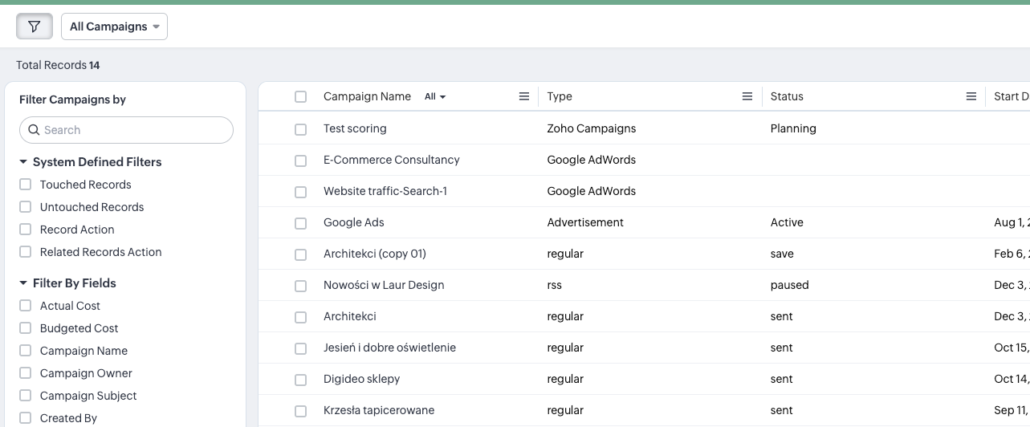
Social
Social Ads
Amplify brand and community stories; Reach customers by social profile and activity; Optimize social ad campaigns in real-time.
Social Sharing
Add intelligent social share buttons to your campaigns and content. Track who is sharing your content and driving conversions.
Social Campaigns
Schedule automated posts to one or more social accounts; use or integrate with URL shortening services; and measure likes, comments, replies, and retweets.
Social Engagement
Social apps, including polls, sweepstakes, and referral programs, can enhance audience engagement. Include these on your website, landing pages, Facebook pages, and emails.
Social Listening
Monitor what leads and contacts say on sites like Facebook, Twitter, YouTube, LinkedIn, blogs, and online communities. Incorporate into your lead and customer DB and use social insights to segment prospects. Trigger campaigns and update lead scores.
Reporting & Analytics
Basic Reporting
Access pre-built and custom reports and dashboards to measure leads by source/campaign/month, email performance, landing page performance, and web and social activity. Create report subscriptions that can automatically send updates to your team and executives.
Revenue Analytics
Analyze how leads flow through the funnel by measuring stage-to-stage conversion rates and velocity. Allocate pipeline and revenue credit among all the marketing activities that have successfully touched an opportunity as it moves through the pipeline.
ROI Analytics
Measure leads, prospects generated, pipeline, revenue, investment, and ROI by marketing channel or program. The result is that you can see which marketing investments generate the greatest return and get visibility into how the marketing budget should be allocated going forward.
Web Analytics
Track which pages prospects and customers visit and how often they come back. Capture the history in the database for lead scoring and sales intelligence. Use anonymous company look-up to identify anonymous visitors. Send alerts to sales reps of which their prospects and customers’ web activity.
SEO / Keyword Analytics
Monitor and track how you rank for relevant keywords on major search engines and compare your overall performance to competitors.
Platform
Sandbox / Test Environments
Allows administrators to develop and test changes to the CRM deployment easily. After changes are made, admins can easily migrate the changes to the “live” or “production” environment. Zoho CRM has Sandbox. We use it in each project.
Customization
The system provides sufficient customization to meet business requirements.
Workflow Capability
Automates a process that requires a series of steps that typically require intervention by several different users. Administrators can write rules to determine who and when a user needs to complete a step. Also includes notification of users when they need to take action.
The user, Role, and Access Mgmt.
The ability to grant access to select data, features, objects, etc, based on the users, user role, groups, etc.
Internationalization
Enables users to view and transact business with the same content in multiple languages and currencies.
Performance & Reliability
The software is consistently available (uptime) and allows users to complete tasks quickly because they are not waiting for the software to respond to an action they took.
Output Document Generation
Allows administrators to create templates that enable users to quickly generate dynamic documents in various formats based on the data stored in the application.
Integration
Data Import & Export Tools
Ability to input, modify, and extract data from the application in bulk through a structured file.
Integration APIs
Application Programming Interface – Specification for how the application communicates with other software. APIs typically enable integrating data, logic, objects, etc, with other software applications.
The Breadth of Partner Applications
To what extent are there partner applications readily available for integrating into this product? Partner applications typically provide complementary, best-of-breed functionality not offered natively in this product.
Summarizing
We help in analyzing your needs and propose an adequate marketing automation tool. There can be many aspects to consider. We just mentioned a high-level list of topics. Buying a marketing automation tool can be very simple if you start your business and complex if you run other marketing software.
For small companies, we always suggest choosing the simplest tools like Agile CRM, Zoho CRM, Bigin, or simple MailChimp. Once you grow, you can always move to other software.
Just let me know if you need help choosing the best marketing automation tool for your business.
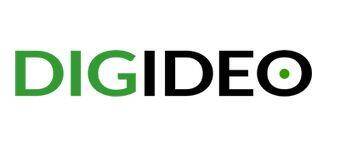
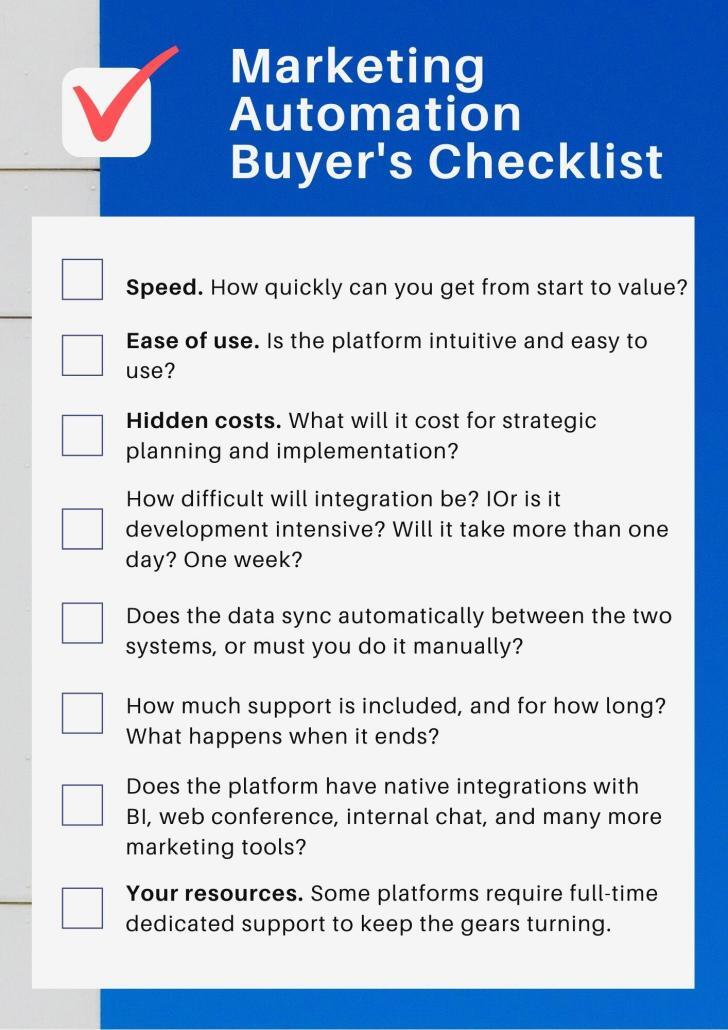

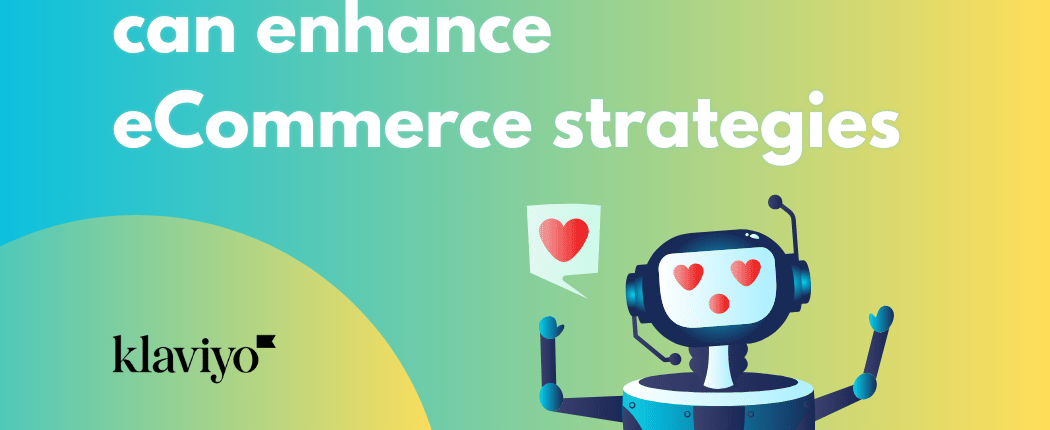

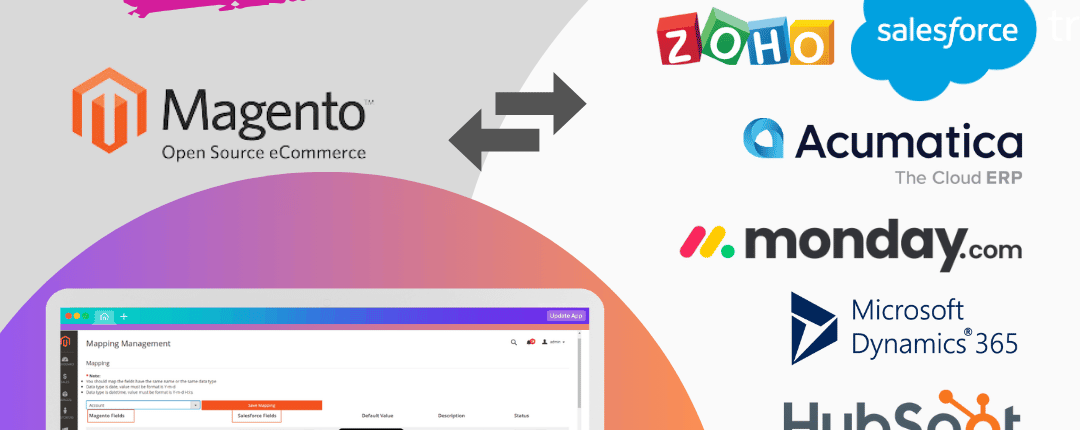


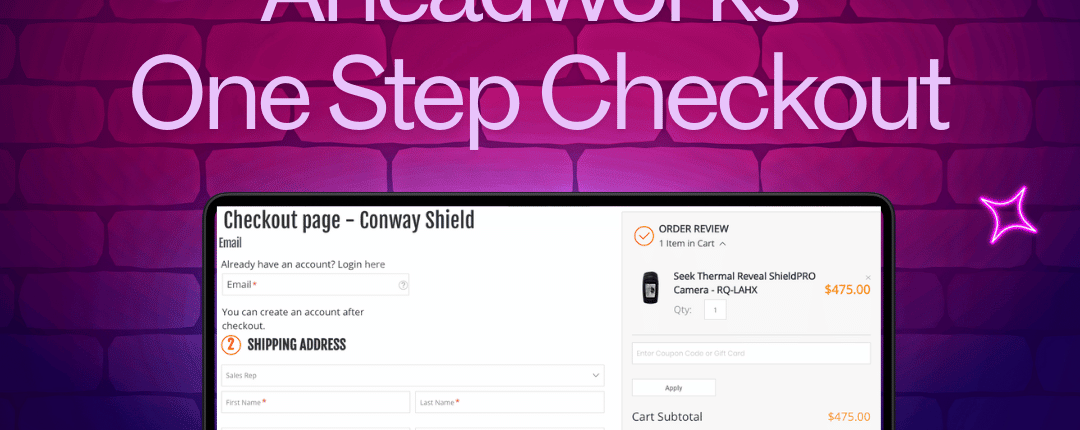



Share this entry